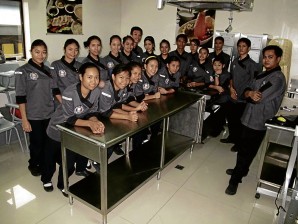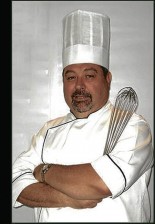Learning thyme for aspiring chefs

WITH the guidance of chef Jean-Pierre Migné and his assistant, Jan Aranillo (right), members of Class 2013 of Tuloy Culinary Arts School are determined to make the most of the free training they are getting. Eugene Araneta
For this group of 18-year-olds, who did not know parsley from rosemary, basil from dill, the field of culinary arts was an alien world.
They gleefully admitted that familiarizing themselves with the various cooking herbs and spices was one of the first hurdles they had to overcome, as they started their training to become chefs.
French cuisine was specially challenging—“kakaiba ang ingredients at mas marami (the ingredients are so different and there are so many).” And expensive, too, they added.
Not knowing the various herbs might not seem all that surprising, even for aspiring chefs. After all, Filipino cooking does not really require these ingredients.
What would seem stranger was that even things ordinary cooks took for granted were new to the culinary students. “We were surprised to learn we had to use different knives and chopping boards and pots and pans for different things,” they said.
Article continues after this advertisementAnd the sauces, the gravy, the soup stocks that had to be made!
Article continues after this advertisementHow did this clueless bunch end up in a culinary class?
Blame Fr. Marciano “Rocky” Evangelista of the Salesians of Don Bosco and chef Jean-Pierre “JP” Migné, who are, in effect, trying to bring out the hidden gems in these 20 diamonds in the rough.
The young people are wards of Tuloy Foundation Inc., which Evangelista founded in 1993 to help street children, offering shelter, education and training. They comprise the third group of trainees of the 3-year-old Tuloy Culinary Arts School headed by Migné.
Challenge
The professional chef admitted that whipping the motley crew into shape as culinary artists was a challenge. Meals and many tastes were alien concepts to them.
While most Filipinos had “seven meals a day,” Migné, who has lived in the Philippines for 25 years, said the variations in breakfast, lunch and dinner and everything in-between were lost on his students.
“The idea of a meal is irrelevant,” much less the concept of seven meals a day, he said. “They eat whenever there is food [and often just] go to sleep to forget about food [when there is nothing to eat].”
Until they started their training, a seven-course meal was unheard of. A plate of rice and a little ulam was standard daily fare, Migné said.
As for tastes, Migné said the students started knowing only the basics—sweet, sour and salty. And, being Filipinos, they wanted everything sweet.
Although the cooking part of the program put a lot of emphasis on Filipino and other Asian cuisine, the students had to be introduced to other tastes.
Evangelista said the school, as well as other Tuloy initiatives, survived primarily on donations but Migné proudly pointed out that its resources and facilities were comparable to those of some culinary institutions that charged tens, even hundreds, of thousands of pesos.
The free Tuloy program, the chef said, covered everything, not just cooking. Students learned to be waiters, dishwashers, bartenders, baristas, etc. They were trained in food technology and nutrition, preservation, storage, hygiene and sanitation.
Students said they learned table settings, “skirting” tables, the use of correct ingredients, proper procedure and presentation of food, although Migné said Filipinos were so naturally artistic that “there was no need to waste time teaching them plating.”
Employable
The bottom line, as far as the school is concerned, is to make the trainees employable. With the age of admission set at 18, trainees can immediately apply for jobs upon graduation.
Migné said graduates did not all have to be chefs. That was why they were trained not just to cook but to do other work related to food service.
On the first three days of school, Migné would prepare them for the tough and competitive kitchens they could be working in by showing them video recordings of the popular television reality show, “Hell’s Kitchen,” which British celebrity chef Gordon Ramsay presides over like a tough military drill sergeant, sparing no one’s feelings and sensibilities.
“I do not talk and I just show the DVDs of ‘Hell’s Kitchen,’ then I ask them if they want to continue. But nobody complains, although [some of the] younger ones say this is too bad. I
explain why these things happen, [like] if they are too slow.”
Migné said he also tells them people pay a lot for the pleasure of dining out and they want their money’s worth.
“At the end of the day, a chef is not needed. People can cook. You go to a chef because you have money, you want to taste something you cannot do yourself. Chefs give pleasure to people,” he said.
But Migné stressed that being a chef requires so many things—
leadership skills, mathematics to do budgeting and measurements, etc. “Teaching the kids is a challenge. How do you change people who do not know anything about cooking and turn them into chefs?”
Aside from teaching them to develop a taste for the different ingredients, Migné said he also had to teach them the proper way to handle knives, for instance, so they would not hurt themselves or others.
He had to explain to one student why his allergy to seafood made him unsuitable for the job of chef. The student thought that if he was merely cooking and not eating the seafood, he was safe. Migné explained that just handling the ingredients could trigger an attack.
He said that initially students used “I don’t know” as their shield. So the class tried to teach them everything, like going to the market, so they could not say they did not know, he said.
Although he felt that the title of chef had become overused, attached to people’s names even before they had proven themselves in the kitchen, Migné, to boost his students’ morale and make them more motivated, designed uniforms, a different one for every class, which bore the title “chef” before a student’s name.
All the students live at Tuloy to eliminate the problem of absenteeism due to lack of money for fare or not having had any food for breakfast.
As part of the preparation for the real world, Migné used his contacts and connections in the food industry to expose his students to the kitchens of the best hotels and restaurants in the country, an experience the students relished, proudly proclaiming that, because “Chef” was very strict about hygiene and cleanliness, their kitchen was better than some of those they had visited.
The students also participated in cooking contests to gain exposure.
When doing their on-the-job training, the students started slow and quiet, Migné said, but they were usually admired for being hardworking. As their confidence grew, they became more assertive, better able to cope with the pressure-cooker atmosphere in top kitchens.
Teamwork
The chef said he was careful to remind students that every good job was a team effort. “I never say I’m happy with one person but with the team… good or bad, it’s the team’s work.” Another constant reminder: “Do not look for compliments but avoid complaints—if you achieve that in your culinary life, then you are a very good chef and will succeed.”
He added: “I tell them I do not accept ‘thank you’ and ‘I’m sorry.’ [These are] overused phrases. If you say ‘I’m sorry’ and repeat the mistake, it’s hypocritical. Show you are sorry by not repeating the mistake. Action is more important than words.”
Migné told the students they had to work hard to be what they wanted to be. They needed discipline and to learn values like respect for colleagues—things they could use wherever they went and whatever they did, even if they did not become chefs.
He said, as Evangelista often reminded them, their goal was to bring their wards from the lowest to the highest place they could possibly be.
The training seemed to have allowed the culinary school graduates to take that first step toward this goal. Migné said all of them had found employment and some even went overseas.
As for the current batch, everyone said they were determined to finish the course. They were also unfazed by what awaited them outside the school, confident they had learned enough and had gotten used to hard work to cope with anything.
Their spirits were buoyed by compliments they got from occasional Tuloy guests they had to cook for and serve. “We feel happy if we can please the guests and they are satisfied with the service,” they said.
